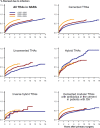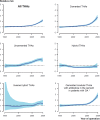Increasing risk of prosthetic joint infection after total hip arthroplasty
- PMID: 23083433
- PMCID: PMC3488170
- DOI: 10.3109/17453674.2012.733918
Increasing risk of prosthetic joint infection after total hip arthroplasty
Abstract
Background and purpose: The risk of revision due to infection after primary total hip arthroplasty (THA) has been reported to be increasing in Norway. We investigated whether this increase is a common feature in the Nordic countries (Denmark, Finland, Norway, and Sweden).
Materials and methods: The study was based on the Nordic Arthroplasty Register Association (NARA) dataset. 432,168 primary THAs from 1995 to 2009 were included (Denmark: 83,853, Finland 78,106, Norway 88,455, and Sweden 181,754). Adjusted survival analyses were performed using Cox regression models with revision due to infection as the endpoint. The effect of risk factors such as the year of surgery, age, sex, diagnosis, type of prosthesis, and fixation were assessed.
Results: 2,778 (0.6%) of the primary THAs were revised due to infection. Compared to the period 1995-1999, the relative risk (with 95% CI) of revision due to infection was 1.1 (1.0-1.2) in 2000-2004 and 1.6 (1.4-1.7) in 2005-2009. Adjusted cumulative 5-year revision rates due to infection were 0.46% (0.42-0.50) in 1995-1999, 0.54% (0.50-0.58) in 2000-2004, and 0.71% (0.66-0.76) in 2005-2009. The entire increase in risk of revision due to infection was within 1 year of primary surgery, and most notably in the first 3 months. The risk of revision due to infection increased in all 4 countries. Risk factors for revision due to infection were male sex, hybrid fixation, cement without antibiotics, and THA performed due to inflammatory disease, hip fracture, or femoral head necrosis. None of these risk factors increased in incidence during the study period.
Interpretation: We found increased relative risk of revision and increased cumulative 5-year revision rates due to infection after primary THA during the period 1995-2009. No change in risk factors in the NARA dataset could explain this increase. We believe that there has been an actual increase in the incidence of prosthetic joint infections after THA.
Figures



References
-
- Danaei G, Finucane MM, Lu Y, Singh GM, Cowan MJ, Paciorek CJ, Lin JK, Farzadfar F, Khang YH, Stevens GA, Rao M, Ali MK, Riley LM, Robinson CA, Ezzati M. National, regional, and global trends in fasting plasma glucose and diabetes prevalence since 1980: systematic analysis of health examination surveys and epidemiological studies with 370 country-years and 2.7 million participants. Lancet. 2011;378(9785):31–40. - PubMed
-
- Doak CM, Wijnhoven TM, Schokker DF, Visscher TL, Seidell JC. Age standardization in mapping adult overweight and obesity trends in the WHO European Region. Obes Rev. 2012;13(2):174–91. - PubMed
MeSH terms
LinkOut - more resources
Full Text Sources
Other Literature Sources
Medical
